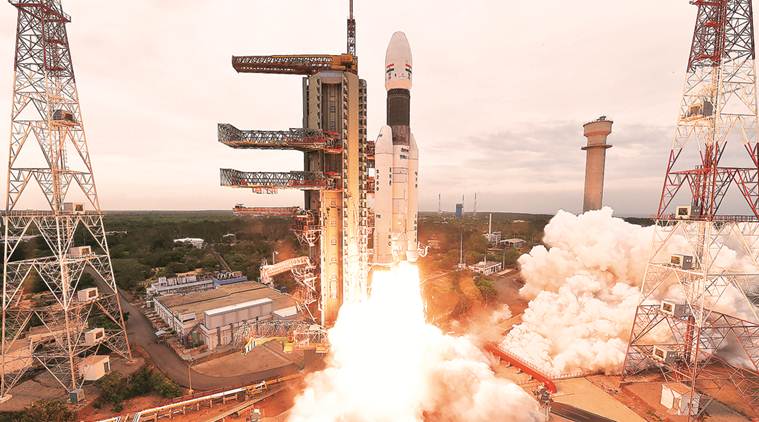- India
- International
Chandrayaan-2: ISRO has the resilience required to rise to the occasion
It was remarkable that in the case of Chandrayaan-2, the problem on the GSLV Mk-III launch vehicle was identified and corrected, and it was launched within a week
 Chandrayaan-2 lifts off from the Satish Dhawan Space Centre on July 22. (Source: ISRO)
Chandrayaan-2 lifts off from the Satish Dhawan Space Centre on July 22. (Source: ISRO)
(Written by Pramod Kale)
The Chandrayaan-2 mission had started out as a highly complex and ambitious mission, far more complex than Chandrayaan-1 and Mars Orbiter Missions. When it was conceived, Chandrayaan-2 was supposed to use the GSLV Mk-II launch vehicle. The rover was expected to be of Russian design and manufacture. But, after the failure in one of its other missions, the Russian agency ROSCOSMOS indicated its inability to supply the rover. Considering the importance of the mission, ISRO then decided to proceed with indigenous design and development of the lander and the rover.
The Chandrayaan-2 mission required a composite spacecraft to be launched. This composite spacecraft consisted of an orbiter, a lander and a rover. Later, the lander was named Vikram and the rover was named Pragyan. After considerable amount of delays caused by the change of the launch vehicle from GSLV Mk-II to GSLV Mk-III, and tests to be carried out on the lander and the rover, the launch was finally scheduled for July 15 this year. I had witnessed the launch of Chandrayaan-1 and the Mars Orbiter. I wanted to be present at the launch of Chandrayaan-2 as well and had gone to the Satish Dhawan Space Centre. Less than an hour before the launch, the countdown was stopped due to a suspected leak in the pressurising system of the cryogenic stage, and the mission was stopped from proceeding. Later it was confirmed that the leak was real and it was certainly good that a timely decision was taken not to proceed with the launch operations.
While I was sitting there in the visitor’s gallery after the announcement stopping the launch operations, I recalled how we had to postpone the launch of INSAT-1A in 1982 due to damage caused to the solar sail of the spacecraft. We were not certain about the corrections required and the time it would take to make fresh attempt at launching it. Eventually, we were able to launch it within two days itself on the Delta launch vehicle of NASA. INSAT-1A developed some problems in the orbit as well. It was launched on April 10, 1982, and by September it was considered a failure because of non-performance of some systems in the orbit. Problems were reported in INSAT-1B, INSAT-1C and
INSAT-1D as well, and while INSAT-1C was declared a total failure, INSAT -B and INSAT-1D served us very well. But these experiences helped us improve our designs for INSAT-2 series of satellites which were very successful.

And so, it was remarkable that in the case of Chandrayaan-2, the problem on the GSLV Mk-III launch vehicle was identified and corrected, and it was launched within a week, on July 22. From the news reports it would appear that the problem was small, but the ground operations involved in correcting it were enormous. The mission planning had to be such that even after the delay of seven days, the final lander touchdown date of September 7 was achieved.
This kind of flexibility is again thanks to our learning from previous missions. Our SLV-3 and ASLV launch vehicles in the early 1980s (the first two launch vehicles developed by ISRO, the precursors of PSLV and GSLV) used to have solid propellant rocket motors in their final stages. A similar solid propellant stage was also used for the perigee raising manoeuvre of the APPLE satellite as well around the same time. But since the time of INSAT series of launches we have been using low thrust liquid bi-propellant propulsion systems for apogee raising manoeuvres. This requires the engines to be operated for long time with multiple restart capability. Right from the first engine firing, we can calibrate the engine performance in orbit and apply corrections in further firings. This technology has been successfully operationalised by ISRO since then.
The mission planning using low thrust capability has been extremely flexible and similar strategy was used for Chandrayaan-1 and Mars Orbiter Missions. The strategy requires multiple manoeuvres at perigee to raise the apogee of the orbit. The mission time is extended but we can realise far more accurate orbits necessary for lunar or planetary missions. If we had used trajectories which require less time to reach to the moon, we might have required much higher thrusts and different engines.
The Chandrayaan-2 composite spacecraft successfully entered the lunar orbit in August and then the Vikram lander separated from the composite spacecraft. The orbit lowering manoeuvres were successfully carried out using the propulsion and orbit control system of the Vikram lander. Ahead of the landing, the deorbiting of the Vikram lander was successfully carried out and Vikram was on its way to the final touchdown. Very close to final landing, some problems were noticed and communications with Vikram were lost. Investigations are being carried out to pinpoint the cause of the problem. It will take some time to fully understand the problem and find the solution. Once the solution is found, ISRO will plan for a repeat mission of soft landing on the Moon. I am certain that we will be able to overcome the problems for the future missions. ISRO has the resilience required to rise to the occasion.
We had problems with SLV-3, ASLV, INSAT series, PSLV and GSLV missions. We learnt from their failures and overcame the problems. The first flight of SLV-3 had seen the rocket fall in the Bay of Bengal five minutes after launch. The first launch of PSLV in 1992 was also a failure, but we were able to correct the problem and in less that two years carried out a successful launch. Since then, we have had string of successes with the PSLV flights.
These days, ISRO is carrying out these missions in full public view with live television coverage. This requires courage and the ISRO scientists, engineers and support staff have that. They have shown that right from the beginning.
This article first appeared in the September 15 print edition under the title ‘History Headline: Learning through failures’. Kale served as director of ISRO’s Vikram Sarabhai Space Centre in Thiruvananthapuram and Space Application Centre in Ahmedabad
EXPRESS OPINION
More Explained
Apr 25: Latest News
- 01
- 02
- 03
- 04
- 05











































